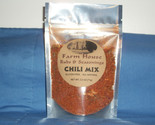FARM HOUSE CHILI MIX
Be
the best chili cook at your next tailgate party, big game or backyard
BBQ. Your friends will rave and thank you for the best bowl of red
they have ever had.
From
the time the second person on earth mixed some chile peppers with meat
and cooked them, the great chili debate was on; more of a war, in fact.
The desire to brew up the best bowl of chili in the world is exactly
that old.
Perhaps
it is the effect of Capisicum spices upon man's mind; for, in the
immortal words of Joe DeFrates, the only man ever to win the National
and the World Chili Championships, "Chili powder makes you crazy." That
may say it all. To keep things straight, chile refers to the pepper pod,
and chili to the concoction. The e and the i of it all.
The
great debate, it seems, is not limited to whose chili is best. Even
more heated is the argument over where the first bowl was made; and by
whom. Estimates range from "somewhere west of Laramie," in the early
nineteenth century - being a product of a Texas trail drive - to a
grisly tale of enraged Aztecs, who cut up invading Spanish
conquistadors, seasoned chunks of them with a passel of chile peppers,
and ate them.
Never has there been anything mild about chili.
Our
travels through Texas, New Mexico, and California, and even Mexico,
over the years have failed to turn up the elusive "best bowl of chili."
Every state lays claim to the title, and certainly no Texan worth his
comino (cumin) would think, even for a moment, that it rests anywhere
else but in the Lone Star State - and probably right in his own
blackened and battered chili pot.
In Spanish, the word chili refers to a ?chili pepper?, and carne means ?meat?. The recipe used by American frontier settlers consisted of dried beef, suet,
dried chili peppers and salt, which were pounded together, formed into
bricks and left to dry, which could then be boiled in pots on the trail.
The San Antonio Chili Stand, in operation at the 1893 Columbian Exposition in Chicago,
helped people from other parts of the United States taste and
appreciate chili. San Antonio was a significant tourist destination and
helped Texas-style chili con carne spread throughout the South and West. Chili con carne is the official dish of the U.S. state of Texas as designated by the House Concurrent Resolution Number 18 of the 65th Texas Legislature during its regular session in 1977.
During the 1880s, brightly dressed Mexican American women known as ?chili queens? began to operate around Military Plaza and
other public gathering places in downtown San Antonio. They appeared at
dusk, when they built charcoal or wood fires to reheat cauldrons of
pre-cooked chili. They sold it by the bowl to passersby. The aroma was a
potent sales pitch; mariachi street musicians joined in to serenade the eaters. Some chili queens later built semi-permanent stalls in the mercado (local Hispanic market).
Before World War II,
hundreds of small, family-run chili parlors (also known as ?chili
joints?) could be found throughout Texas and other states, particularly
those in which emigre Texans had made new homes. Each establishment
usually had a claim to some kind of secret recipe.
As early as 1904, chili parlors were opening outside of Texas. After working at the Louisiana Purchase Exposition, Charles Taylor opened a chili parlor in Carlinville, Illinois, serving "Mexican Chili".[3] In
the 1920s and 1930s chains of diner-style "chili parlors" grew up in
the Midwest. As of 2005, one of these old-fashioned chili parlors still
existed on Pine Street in downtown St. Louis. It features a chili-topped dish called a "slinger": two cheeseburger patties, hash browns, and two eggs, and smothered in chili.[4]
One of the best-known Texas chili parlors, in part because of its downtown location and socially connected clientele, was Bob Pool's "joint" in Dallas, just across the street from the headquarters of the elite department store Neiman Marcus. Stanley Marcus,
president of the store, frequently ate there. He also bought Pool's
chili to send by air express to friends and customers across the
country. Several members of General Dwight Eisenhower'sSHAPE staff during the early 1950s were reported to have arranged regular shipments of chili from Pool's to their Paris quarters.
There
has forever been a controversy about ingredients: beans, no
beans.....tomatoes, no tomatoes.....and on and on. We like BOTH in ours!
For a great starting point, give our Cherry Orchard Foods ?FARM HOUSE?
Chili Mix a try.....and you can do it...YOUR WAY!
OUR RECIPE:
1.
In a large saucepan, add one batch of Farm House Chili Mix (about 2
tablespoons) to one pound of cooked meat (ground chuck), one can tomato
sauce (15oz), one can diced tomatoes (28oz), and two cans of beans
(kidney or pinto, 15oz, drained rinsed), add chopped onion
garlic if desired.
2. Bring to a boil, cover and lower heat, simmer for about 30 minutes. Stir occasionally.
3.
Serve warm in a bowl or bread bowl, topped with shredded cheddar
cheese, sour cream, chopped green onions, and extra crushed red chili
pepper flakes, if desired.
Also Please check out our huge line of dip mixes, dessert mixes and other rubs and seasonings.
With over 50+ dip mix flavors
13 dessert mix flavors
2 Infused party spreads
3 bread dipping oils
and our signature dixie dust and steer dust rubs and seasonings
